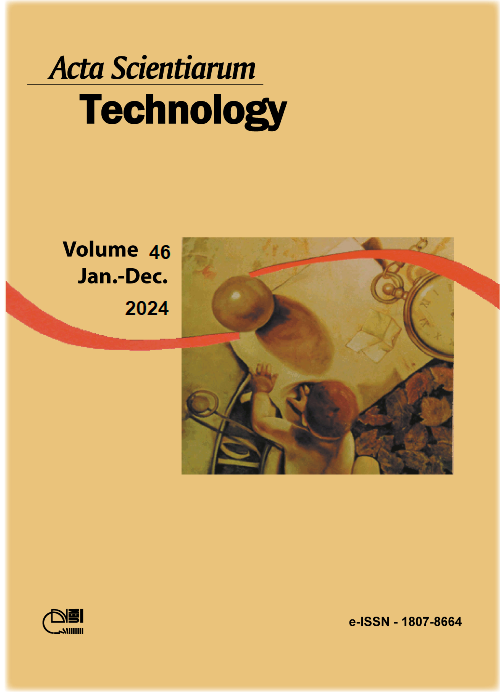Chemical composition of biodiesel produced in situ with Salvinia molesta DS Mitchell (Salviniaceae) by ethylic and methylic route
DOI:
https://doi.org/10.4025/actascitechnol.v46i1.66010Palavras-chave:
direct transesterification; fatty acid esters; gas chromatography; Infrared spectroscopy.Resumo
Macrophytes are aquatic plants that can cause environmental and economic damage due to their rapid growth in eutrophicated environments; however, this characteristic makes these biomasses promising alternatives for biodiesel production. Thus, this study aims to characterize and evaluate the chemical composition of the biodiesel produced from the macrophyte Salvinia molesta DC Mitchell (Salviniaceae). The biodiesel production was carried out in situ through the ethyl and methyl process. Attenuated total reflectance-Fourier transform infrared spectroscopy (FTIR-ATR) and gas chromatography with a flame ionization detector (GC-FID) were used to characterize the product. A commercial sample was also analyzed for comparison purposes. The biofuel produced with ethanol and methanol showed characteristic peaks between 900 to 1300 cm-1 and 1750 to 1735 cm-1 in the FTIR-ATR. Both samples showed less unsaturation degree compared to the commercial sample, with 34.44% of monounsaturated compounds (MUFA) and 36.73% of polyunsaturated compounds (PUFA) for methylic biodiesel, 34.79% of MUFA and 36.89% of PUFA for ethylic biodiesel, and 55.34% of MUFA and 24.14% of PUFA for commercial biodiesel. Samples produced by both routes showed similar chemical composition, with higher contents of saturated compounds than the commercial sample. The average chain size and the number of double bonds are smaller for S. molesta samples, 17.38 and 1.15 for S. molesta biodiesels and 17.65 and 1.41 for commercial biodiesel, respectively. The chemical composition of S. molesta biodiesel demonstrates the potential to be an alternative to commercial biodiesel.
Downloads
Downloads
Publicado
Como Citar
Edição
Seção
Licença
DECLARAÇíO DE ORIGINALIDADE E DIREITOS AUTORAIS
Declaro que o presente artigo é original, não tendo sido submetido í publicação em qualquer outro periódico nacional ou internacional, quer seja em parte ou em sua totalidade.
Os direitos autorais pertencem exclusivamente aos autores. Os direitos de licenciamento utilizados pelo periódico é a licença Creative Commons Attribution 4.0 (CC BY 4.0): são permitidos o compartilhamento (cópia e distribuição do material em qualqer meio ou formato) e adaptação (remix, transformação e criação de material a partir do conteúdo assim licenciado para quaisquer fins, inclusive comerciais.
Recomenda-se a leitura desse link para maiores informações sobre o tema: fornecimento de créditos e referências de forma correta, entre outros detalhes cruciais para uso adequado do material licenciado.



















